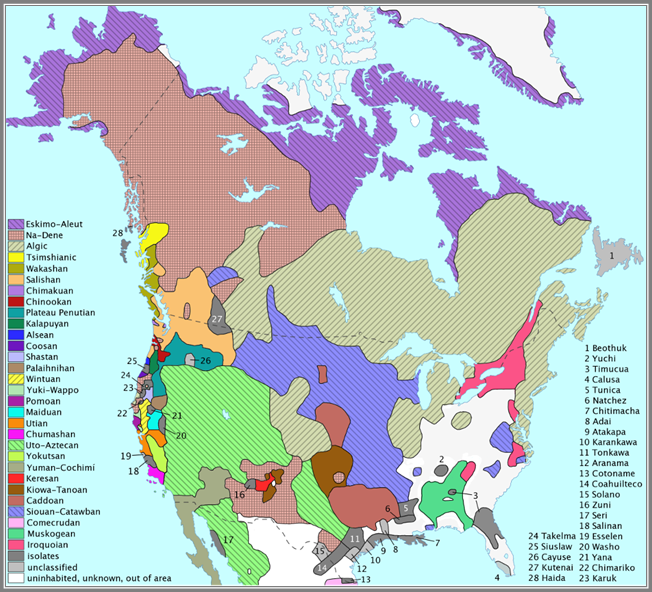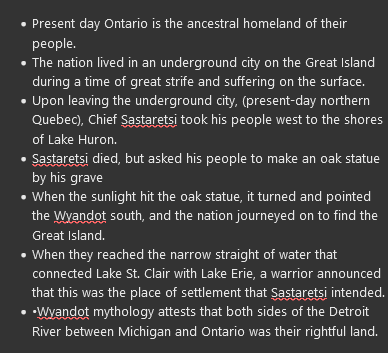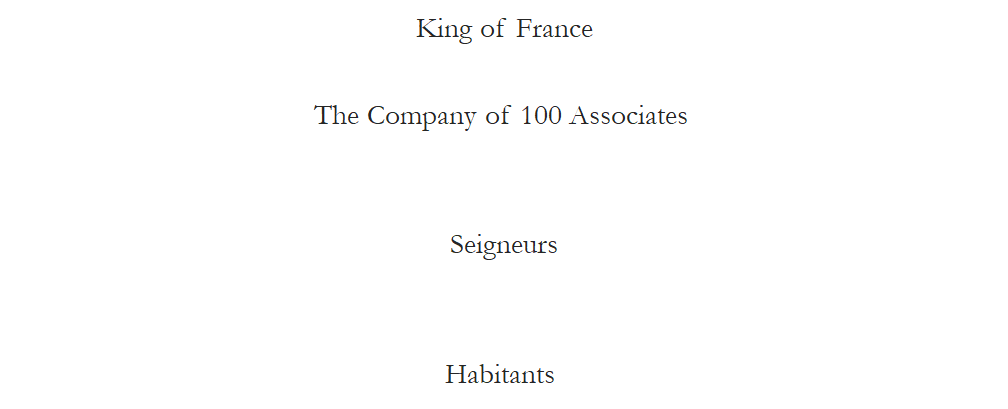History Test 1
1/59
Earn XP
Description and Tags
Name | Mastery | Learn | Test | Matching | Spaced |
|---|
No study sessions yet.
60 Terms
History is a “written record”, and much of Indigenous History is founded on oral accounts.
Why are Indigenous History and Canadian History often separated?
Now incorporates oral history, artwork, material culture, and archeology.
Oral history is now a growing field in academia.
What has the evolution of ethnohistory done?

Over 500 different indigenous societies with different cultures, languages, and traditions.
Map shows Indigenous linguistic and cultural families.
How many different, unique Indigenous societies are there?
The flood myth; Nehiyawak Plains Cree Nation
Turtle Island myth; Wyandot Nation
Journey towards the setting sun; Peskotomuhkatiyik, Penobscot, and Wuastukwiuk, and Mi’kmaq
Although indigenous nations are incredibly diverse, what creation myths are shared among cultures?

Believe they are descendants of the Sky People from the Sky World.
A young woman in this realm touched a forbidden crab apple tree and became terminally ill.
An ancient medicine man ordered the Sky-people to dig to the roots of the forbidden tree to find the elixir within.
The tree fell through the ethereal realm to the bottom of the waters of the underworld.
The woman crashed into the ocean and was rescued by two swans who put her on the Big Turtle’s back.
An Otter, Muskrat, Beaver, and Grandmother Toad swam to the forbidden tree.
Each animal tried and failed to retrieve pieces of the earth, except Grandmother Toad who died upon returning to the surface.
The Earth was placed on the back of the Big Turtle next to the dying woman and an island grew on the back of the turtle while the woman began to recover.
Describe the Wyandot Creation Myth.

Present day Ontario is the ancestral homeland of their people.
The nation lived in an underground city on the Great Island during a time of great strife and suffering on the surface.
Upon leaving the underground city, (present-day northern Quebec), Chief Sastaretsi took his people west to the shores of Lake Huron.
Sastaretsi died, but asked his people to make an oak statue by his grave
When the sunlight hit the oak statue, it turned and pointed the Wyandot south, and the nation journeyed on to find the Great Island.
When they reached the narrow straight of water that connected Lake St. Clair with Lake Erie, a warrior announced that this was the place of settlement that Sastaretsi intended.
•Wyandot mythology attests that both sides of the Detroit River between Michigan and Ontario was their rightful land.
What happened to the Wyandot people after the creation of their earth?
Ancient knowledge of the geography of North America
Sophisticated understanding of regional ecosystems
Understanding of human migratory patterns
In what ways are Indigenous knowledge sophisticated?
Sometime in the last Ice Age, Last Glacial Maximum
(approx. 28,000- 13,000 years ago)
When did The First Peoples migrate to North America?
Between 12,000 to 14,000 years ago
According to most scholars, when were modern hominids in North America?
North & South America.
What were the last continents to be inhabited by people?
Of Asian ancestry
Came in waves
What was American migration like?
Suggests that some people arrived in the Americas by following the coast of Asia and Beringia, down the western shore of North America, all the way to South America.
(Maritime routes; ocean travel)
What is the Coastal Route Theory of migration?
Theorized that the First People of NA had traveled across a bridge of ice that connected Asia and the Americas the Bering Strait.
What is the Bering Land Theory of migration/Clovis FIrst Model?
Suggests that North Americans did not migrate from Asia, but were descendants of Europeans.
Has been disproven.
Was used to justify colonialism.
What is the Solutrean Theory of migration?
The Beringian Standstill Hypothesis, also known as the Beringian Incubation Model (BIM), proposes that the people who would eventually colonize the Americas spent between ten to twenty thousand years stranded on the Bering Land Bridge (BLB), the now-submerged plain beneath the Bering Sea called Beringia.
Evidence of Paleo-Americans dating to 28,000 BCE at the Bluefish Caves. (Yukon, Canada) supports the hypothesis.
What is the Beringian Standstill Hypothesis?
Found genetic link between Clovis child in Montana (12,800 years ago) to the oldest found Chilean, Brazilian, and Belizean individuals.
In 2018, a study was published that analyzed the genomic data of more than 60 individuals who lived in the lands between Alaska and Patagonia 700 to 10,000 years ago. What did they find?
Decentralizes the Eurocentric view.
By beginning our historical narrative of Canada in the West we centralize indigenous perspectives into our study.
Why is it important to learn “West to East”?
Densely populated region home to various nations.
Food sources were abundant; higher quality of living.
Unique stratified social hierarchy; house groups. Elites, commoners, and slaves.
Unique languages; many derivatives.
Potlach was an important cultural ceremony.
What were Indigenous Societies in the Northwest Coast like?
A ceremonial distribution of property and gifts to affirm or reaffirm social status
What is a Potlach?
Inhabited the Haida Gwaii region (modern British Columbia coast and islands).
Lived in permanent settlements protected by large palisaded walls. (Spiky)
Each village was an independent political body.
2 clans: Eagle or Raven. Followed matrilineal line.
Built long canoes using cedar trees.
Famous for crafting totem poles.
What was The Haida like?
Two classifications of Plains inhabitants: Northern buffalo hunters; Southern agriculturalists. Both Nomadic peoples.
Algonquin languages
Cultural practices: Sundance, Medicine Ball, Counting Coup.
Utilized advanced environmental knowledge.
What were Indigenous Societies in the Plains like?
Held power over vast amounts of territory in modern day Saskatchewan and Manitoba.
Participated in hunting, primarily buffalo, and some gathering for subsistence.
Political structure: Male chief chosen based on personal achievement and hunting skills. The actions of the chief were guided by a council made up of representatives from each family group within the nation.
What was The Assiniboine like?
Language families: Dene (Athabaskan) and Salishan
Sedentary villages, though in the summer travelled to hung.
Egalitarian society, but stratified by gender. Men made most of the decisions
Division of labor divided by gender.
Egalitarian resource economy. Shared amongst all.
What were Indigenous Societies of the Plateau like?
Made up of multiple nations: Lil’wat, Secwepemc, Ntlakapamux, Okanagan, and Sinixt.
Hunter-gathers who travelled for food, but had winter "pit houses."
Each village had several chiefs who were chosen based on merit.
Though all men took part in decision making for the community .
What was The Interior Salish Culture like?
Spanned from the Western Great Lakes, to Eastern Maritimes to North Carolina.
Iroquoian and Algonquian languages and traditions.
Relied on the three sisters: Corn, beans, and squash. Cultivated sacred tobacco.
Iroquoian peoples=Sedentary with large villages
Algonquian peoples= Seasonal settlements; migrated with the seasons.
What were Indigenous Societies of the Eastern Woodlands like?
Traditional homeland was the Eastern Woodlands.
Migratory people who travelled the Canadian Boreal forest region.
Social structure made up of small, independent family clans.
Part of the larger Anishinaabeg cultural group. Close relatives to Algonquians.
Established a vast and intricate trading network.
What was The Ojibwa like?
Linguistic groups: Dene, Cree, Ojibwe, Atikamekw, Innu, and Beothuk.
More cultural diversity amongst the Dene.
Hunter-gathering society. Could not grow crops. Lived by hunting, fishing, trapping, and gathering food.
Indigenous fur trade.
Small communities. Migrated within a specific territory.
What were Indigenous Societies of the Subarctic like?
Traditional territory modern day Maritime provinces (Nova Scotia, Newfoundland, Labrador)
Migratory peoples. Spent spring and summer on Atlantic seaboard and fall and winter in the Maritime interior.
Communities organized by alliance and kinship.
Regional leadership focused on management of fishing and hunting economy.
Mi'kmaq Grand Council
What was The Mi'kmaq like?
Harsh environment. Summer=long day light hours. Winter=intervals of total darkness.
Society made up of regional bands based on family.
Family was very important both socially and economically.
Migratory peoples.
What were Indigenous Societies of the Arctic like?
Inhabited the far north Canadian tundra.
Hunted large marine animals; whales, walruses, and seals.
Social structure less formal.
Inuktitut language.
Migratory people; winter and summer camps
What was The Inuit like?
Different environments created different resources and different needs.
Trade allowed certain nations to obtain resources that were not native to or available in their region.
Why was trade important?
Intimate relationship to the land and environment.
Tied to culture, spirituality, social systems, and politics.
Each nation held their traditional territory.
Within a given territory, the land, water, and resources were there for the benefit of the entire community and were meant to be shared, respected, and preserved for future generations.
Sharing was a common cultural trait among all indigenous nations in North America.
What were Indigenous Conceptions of land and resources?
Christopher Columbus; Italian
Who led the age of “discovery”, and what nationality were they?
Ferdinand II & Isabella I of Spain
Who funded the age of “discovery”, and what nationality were they?
Searched for passage to Asia
Landed in the Bahamas 1492
Where were the early colonizers headed, and where did they end up?
Portugal
Dutch Republic
France
England
Spain (in the lead)
What countries were racing to colonize North America, and which one was in the lead?
Global causes:
Bubonic plague in Europe
Nationalism on the Rise.
New Marine technology; cog hull.
European causes:
Fame
Political influence
Riches; GOLD
What were some of the purposes for racing to colonize North America?
Giovonni da Verrazzando; Italian
Searched for Asian passage, instead landed in New York and Newfoundland.
Who was the first European explorer to find North America? What nationality was he, and where did he land?
Francis I, King of France sponsored
France laid claim
Who was the first colonizer to find North America funded by, and which country ultimately laid claim to the land they “discovered”?
A French mariner ordered to find new land and gold in 1534
1st Voyage:
Found Iroquoian village of Stadacona (near Quebec City).
Chief Donnacona told of a rich, Western kingdom: Saguenay.
2nd Voyage:
Almost dies of Scurvy. Saved by Domayaga.
Kidnaps Donnacona, 2 sons, and 7 other Iroquoian citizens. Brings them to France. All but 1 women died.
Who was Jacques Cartier, and what did he do?
Elizabeth I's pirate; English
Searched for Northwest passage into Asia
Baffin Islands
Brought back 1,000 of pounds of worthless sandstone.
Who was Martin Frobisher, and what did he do?
French exploration:
Internal political issues; Hugeunots and Catholics.
English exploration:
Protestant Reformation.
Elizabeth I's reign.
Which countries experienced stalling in exploration, and why?

the widespread transfer of plants, animals, precious metals, commodities, culture, human populations, technology, diseases, and ideas
Lead to more and more European exploration
The Great Dying
60% loss of indigenous population.
Disease proceeded contact
What was the Columbian Exchange?
Modern day Nova Scotia
1st posts established by Du Gua de Monts and Samuel de Champlain; Port Royal and Douchat in 1605
De Monts returned to France
Underfunded.
What was the French Acadia?
Samuel de Champlain; founded in 1608
Was previously an Iroquoian village called Stadacona
1st winter; scurvy hits
25 men, down to 9
Indigenous alliances with Wendat and Algonquin nations necessary
Haudenosaunee became enemies
France entering indigenous politics
Had to be Catholic
NO WOMEN
Who founded Quebec City and when, and what was early life like?
Indigenous would not allow French to enter their fur trade.
Wendat remained in control.
French colonization in North America is behind.
The joke of the European world.
Why were French settlements failing?

a French trading and colonization company chartered in 1627 to capitalize on the North American fur trade and to expand French colonies there.
Era: 1627-1663
Cardinal Richelieu under Louis XIII supervised
107 French businessmen; 3,000 livres each (livre: French currency at the time)
Created feudal system in New France (feudal system: a combination of legal, economic, military, cultural, and political customs that flourished in medieval Europe between the 9th and 15th centuries)
Major turning point even with huge losses
What was the Company of One Hundred Associates?
A British colony
1610 settlement begins
1660s: 1,500 settlers
British era of proprietary government; Ruled by Governor
James I Charter to London & Bristol Company
Followed English law, but also followed rules of the company
Describe English Newfoundland.
War between British and French (Anglo-French War) 1626-1629 in Europe
1629-1630: British intercept all supply ships destined for Quebec City
1627: Kirke brothers take Port Royal and Tadoussac Acadia
1629: Kirke brothers take Quebec City
Persisted until the Treaty of Saint-Germaine
How did the British harass French Acadia?
Last half of the 17th century, Acadia tossed between British and French control.
Created unique culture.
Settlers apathetic to political control.
La Petite Guerre (a form of irregular warfare where small units attack the enemy's support operation to ensure that the main force enjoys favorable conditions for decisive battles) beginning in 1660s
Flourishes between 1650-1690
What happened to Acadia once it was isolated?
Recollects; 1615
Jesuits; 1625
The Ursulines; 1639
What were the different eras of religious groups in New France?
Started by Ignatius Loyola
"Society of Jesus"
Education is key.
Indigenous conversion.
Division and upheaval in indigenous society
Named "Black Robes"
Describe key factors of the Jesuits.
Jesuits used indigenous language, customs, and culture to infiltrate communities.
Wendat divided by Jesuits
St. Joseph's mission in Wendake
1630s-1640s smallpox epidemic in New France
Wendat population devastated. Black Robes blamed.
Violence against Jesuits became prevalent.
Describe the relationship between the Jesuits and the Wendat peoples.
Haudenosaunee attacks on Fur Trade
Company of One Hundred Associates withdrew, Communate des Habitants took over.
Wendat extremely weak. Haudenosaunee strike.
Huronia/Wendake destroyed.
War continued for decades.
What were the Mourning Wars?
Peace Treaty 1701
Ended Mourning Wars
Haudenosaunee agreed to peace.
No interference in French/British conflicts
What was the Great Peace of Montreal?
1665: Filles Du Roi or "King's Daughters"
800 women brought between 1665-1673
Population growth from within. Not as dependent on immigration
What helped grow New France’s population?

Louisiana territory
Crescent-shaped empire
Courers De Bois (independent entrepreneurial French Canadian traders who travelled in New France and the interior of North America, usually to trade with First Nations peoples by exchanging various European items for furs. Some learned the trades and practices of the indigenous peoples)
Trading posts
Power still in Quebec
Detroit River Borderlands: The French Frontier
1701 Antoine de la Mothe Cadillac established Fort Ponchartrain du Detroit (Hart Plaza, Detroit)
Fur Trade; invited indigenous nations to settle following Mourning Wars
1706 Expansion began
What did New France’s new grounds look like?
long, narrow land divisions, usually perpendicular to a waterway
250-400 feet wide, 3 miles long
1747 Ribbon farms extended to modern day Essex County
One French region
Close indigenous relations
What were the French Ribbon Farms of Detroit River?
Indigenous slavery; Mourning Wars
Fewer African slaves
Code Noir: Black Code 1685 (a set of laws that governed the practice of slavery in the French colonies; required owners to provide slaves with food, shelter, and clothing)
Slavery abolished in France in 1794
What did slavery look like in New France?
#1 Economic resource in French North America
Infiltration of Indigenous Communities
The Metis
What did the French fur trade look like?